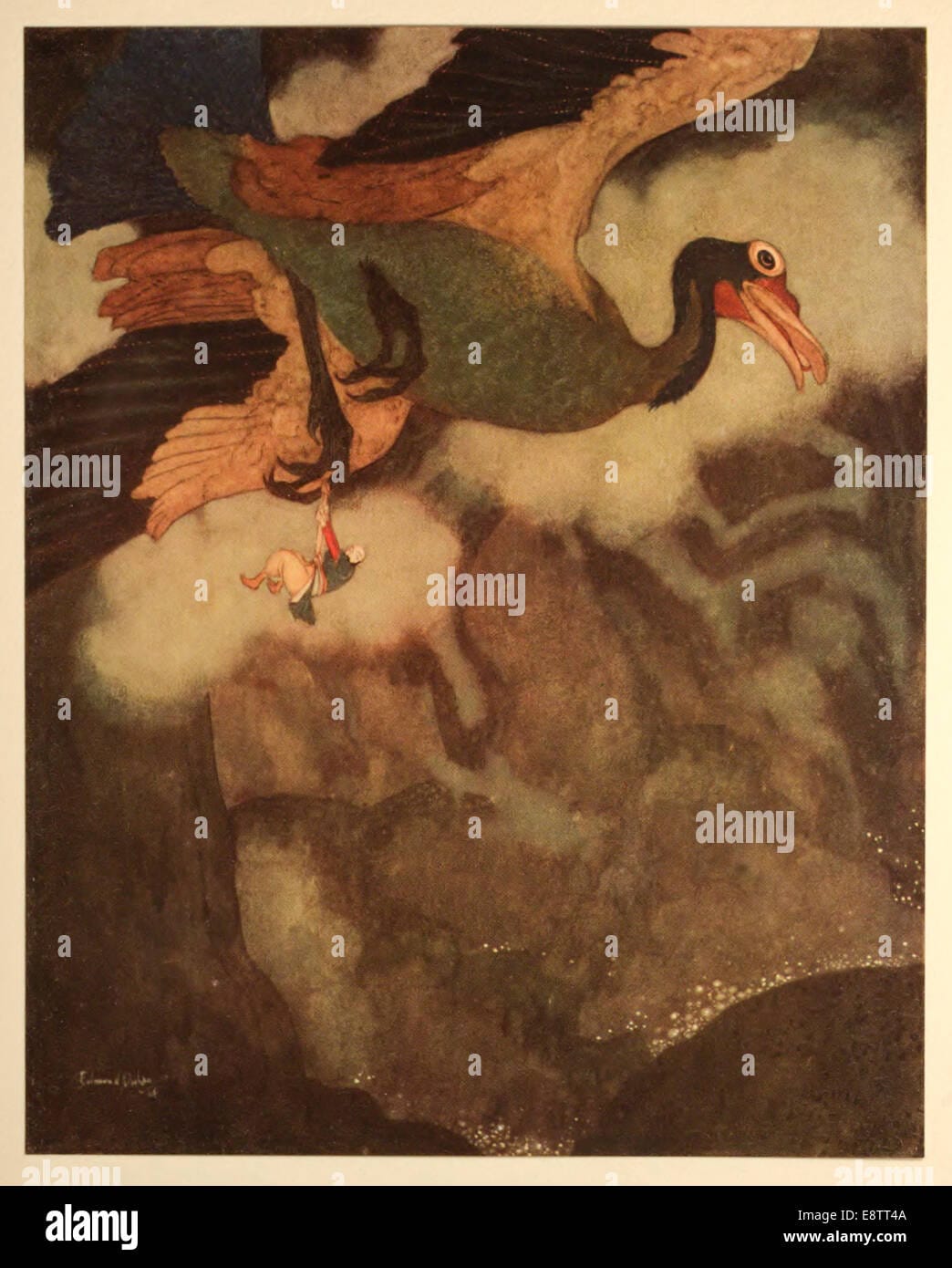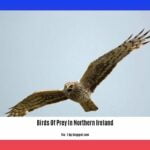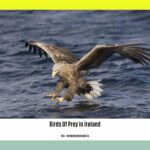They say that in the realms of Arabia, in a land where myths and legends dance, there are tales of legendary creatures that soar through the skies – the Rocs. These birds, they say, aren’t just any ordinary birds—they’re gigantic, with wings that can eclipse the sun and claws that can crush mountains. They are the stuff of legends, creatures that have captured the imagination of people for thousands of years.
The Roc: Terror of the Skies
The Roc. This name alone conjures up images of a creature so immense, so powerful, that it seems impossible. Yet, this legendary bird, a recurring character in the captivating tales of the Arabian Nights, continues to fascinate and inspire us centuries later. Let’s delve into the origins, attributes, and lasting impact of this majestic creature.
Whispers of a Titan: Origins and Legends
The Roc’s story likely began long before it was ever featured in the Arabian Nights. Whispers of a colossal bird of prey, known then as the “Rukh,” circulated throughout ancient Middle Eastern mythology. This behemoth wasn’t content snatching mere field mice; the Rukh was said to be capable of carrying off elephants in its talons! Imagine the stories told around campfires, the fear and awe in the eyes of those who claimed to have witnessed this magnificent creature in flight.
These tales, passed down through generations, eventually found their way into the hands of storytellers, weaving their way into the adventures of Sinbad the Sailor in the famous collection, “One Thousand and One Nights.” It’s here that the Roc, no longer a mere whisper in the wind, takes center stage as one of the most memorable and awe-inspiring creatures in all of literature.
A Creature of Immense Power: Physical Attributes and Prowess
Picture this: an enormous eagle-like being, its wingspan so vast it could blot out the sun. That’s the Roc as described in the stories. This wasn’t just a big bird; it was a force of nature. Its talons, said to be sharper than any sword, could pierce the thick hides of elephants with ease. The Roc’s strength was so immense it was said to be able to carry off not only elephants but also rhinoceroses, and some tales even speak of whales snatched from the sea, vanishing into the clouds in the grip of this feathered titan.
The sheer size and strength attributed to the Roc cemented its place in our collective imagination, a testament to humanity’s fascination with the boundless possibilities of the natural world.
Beyond the Physical: Symbolism and Significance
The Roc embodies the raw, untamed power of nature. It’s a reminder that there are forces in this world far greater than ourselves, capable of inspiring both wonder and fear in equal measure. For the ancient explorers who dared to venture into the unknown, the Roc served as a potent symbol of the unexpected dangers that might lurk beyond the horizon. It embodied the very essence of the unexplored world, a stark reminder that for all of humanity’s progress, nature remained a force to be reckoned with.
But the Roc is more than just a symbol of danger. It also represents freedom, power, and the boundless possibilities of the imagination. In a world bound by limitations, the Roc reminds us that there are no limits to what we can dream up.
Fact or Fiction? Real-World Inspirations
While the Roc is a product of mythology, some scholars believe its origins may be linked to real creatures. Could the extinct Elephant Bird of Madagascar, a flightless giant that towered over 10 feet tall, have sparked the initial tales of a bird large enough to carry off large mammals? Or perhaps ancient mariners, encountering the massive nests of large birds of prey, mistook them for something far more extraordinary.
Others point to exaggerated accounts of large birds of prey, such as the now-extinct Haast’s Eagle of New Zealand, a formidable predator known to have hunted the massive Moa birds. Perhaps stories of these impressive birds, embellished with each retelling, morphed over time into the legend of the Roc we know today.
A Legacy of Wonder: Cultural Impact
The Roc’s influence extends far beyond the pages of the Arabian Nights. This mythical bird has taken flight in art, literature, and even video games, continuing to captivate audiences across generations. Its enduring presence reminds us of the power of storytelling and our innate fascination with the extraordinary. From the epic poems of ancient Persia to modern fantasy novels, the Roc has left its mark on our collective consciousness.
The Roc, a creature born from imagination, continues to soar high in the realm of myth and legend. It serves as a powerful reminder that even in a world increasingly dominated by technology and rationality, the human spirit still yearns for the magic and wonder embodied by the creatures of myth.
Birds of Legend: Exploring Other Mythical Avian Creatures of Arabia
We’ve already heard about some amazing creatures from Arabian myths, but get ready to fly high with tales of incredible birds! These aren’t your everyday pigeons – we’re talking about majestic beings with powers beyond imagination.
The most famous of these feathered legends is the Roc, a bird so massive it could easily scoop up an elephant for dinner – talk about a takeaway! You might have heard whispers of the Roc from the famous collection of stories, “One Thousand and One Nights,” which introduced this incredible creature to the Western world. But the Roc’s story goes way back, deeply rooted in ancient Arabic tales passed down through generations.
However, the Roc isn’t the only mythical bird soaring through Arabian lore. Let’s meet a few more:
The Anqa: This isn’t your average birdhouse resident! Imagine a bird wreathed in flames, said to live forever. That’s the Anqa – a symbol of immortality and power. Some believe that the Anqa is connected to the Phoenix of Western mythology, a creature reborn from its own ashes. Could these two fiery birds be linked in some way, separated by geography but united by a shared symbolism of renewal and rebirth?
The Simurgh: This benevolent creature seems like it flew in from a fantasy dream! Picture a peacock shimmering with iridescent beauty, but with a surprising twist – it has the head of a dog and powerful claws like a lion. The Simurgh represents kindness, wisdom, and the strength to overcome any obstacle. It’s often depicted as a protector of heroes and a guide for those on a spiritual quest.
The Hudhud: Ever heard stories of birds with magical abilities? The Hudhud, a type of hoopoe bird, fits the bill! This clever bird is believed to possess extraordinary powers and often acts as a messenger and guide in Arabic mythology. In the Quran, the Hudhud plays a significant role in the story of King Solomon, acting as his messenger and scout.
These winged wonders are more than just characters in stories; they represent the power and mystery of the natural world and the hopes, dreams, and aspirations of the people who told their tales. Some experts suggest that these birds may also symbolize human qualities – the strength of the Roc, the wisdom of the Simurgh, the everlasting spirit of the Anqa – making them even more relatable despite their fantastical nature.
From epic poems to fireside stories, these mythical birds have been captivating imaginations for centuries. It makes you wonder, what other secrets are hidden within the rich tapestry of Arabian mythology, just waiting to be discovered?
Roc: A Name Etched in Legend
We’ve already been on quite the journey exploring mythical creatures, so let’s dive right back in! This time, we’re talking about a legendary bird so massive, it’s said to have carried off elephants in its talons! You guessed it, we’re unraveling the mystery of the R–O–C.
Imagine a bird so large it could blot out the sun as it soared through the sky. That’s the image evoked by the Roc in ancient stories, particularly those from Arabia. This majestic creature, often depicted as a colossal eagle or falcon, has been a source of fascination for centuries.
The Roc isn’t just some random giant bird, though. It’s a prominent figure in famous stories like “The Thousand and One Nights,” most notably in the adventures of Sinbad the Sailor. Remember those tales where Sinbad encounters all sorts of unbelievable wonders and dangers? Well, the Roc plays a key role in several of them, sometimes as a terrifying force and other times as an unexpected source of aid.
What makes the Roc so captivating goes beyond its sheer size. It embodies the raw power and unpredictability of nature itself. In Arabian folklore, encountering the Roc is like facing the unknown head-on, a mix of awe-inspiring wonder and heart-pounding fear.
Interestingly, the idea of a giant bird isn’t unique to Arabian tales. Cultures across the globe have their own versions of such magnificent creatures, each reflecting their beliefs and understanding of the world. Think of the Thunderbird in Native American stories or the Garuda in Hindu mythology – all testaments to humanity’s enduring fascination with the boundless possibilities of imagination.
And the Roc’s story doesn’t end there. Even today, this legendary bird continues to soar through the realms of fantasy literature, movies, and video games. Sometimes it’s portrayed as a fearsome beast, other times as a symbol of incredible power and majesty. Regardless of the depiction, one thing remains constant: the Roc’s ability to spark our imagination and remind us of the enduring allure of mythical creatures.
The Roc: Lord of the Arabian Skies
So, we’ve been talking about these awesome creatures in Arabian mythology, and now it’s time to introduce you to the big kahuna of the bird world – the Roc. Imagine a bird so massive it could snatch an elephant right off the ground, no problem! That’s our Roc. This legendary bird is all over the place in Arabian lore, especially in those classic “One Thousand and One Nights” stories.
This wasn’t just some random monster, though. The Roc was the apex predator, and we’re talking megafauna here – elephants, rhinos, maybe even whales! Some stories say it made its home on a mythical mountain called Kaf, which was believed to be like the edge of the world, separating everything we know from the unknown. That’s some serious mystique right there.
Now, let’s talk about what made this bird so special. We’re talking massive wingspans, big enough to block out the sun, and talons that make eagle claws look like, well, chicken feet. This thing was powerful. But the Roc wasn’t just about brute strength. It embodied the raw, untamed power of nature itself and served as a reminder that there’s a whole lot out there that we don’t understand.
It’s no surprise that the Roc has been a superstar in literature and art for centuries. From the voyages of Sinbad the Sailor to the writings of Marco Polo, this legendary bird has inspired countless stories, paintings, and even sculptures. It’s like the original giant monster movie, and we still love to be both terrified and amazed by it.
The really interesting thing is that the Roc isn’t just confined to Arabian mythology. Similar stories about giant birds pop up in cultures all over the world, which makes you wonder – was there something that inspired these tales? Was there a real-life bird, now extinct, that was truly enormous? Or are these stories tapping into something deeper, something that speaks to our fascination with the unknown and the creatures that might lurk there?
Whatever the answer, one thing’s for sure: the Roc isn’t just a bird, it’s an icon. It represents the power of nature, the allure of the unknown, and the power of storytelling to capture our imaginations for centuries.
diosa shiva baile is a mysterious and powerful being that appears in various religions and cultures, especially in Hinduism and Buddhism.
- Unlocking Francis Alexander Shields’ Finance Empire: A Comprehensive Biography - July 12, 2025
- Unveiling Francis Alexander Shields: A Business Legacy - July 12, 2025
- Francis Alexander Shields’ Business Career: A Comprehensive Overview - July 12, 2025















